Diamonds (and the Waco Fire) Are Forever
30 years ago today, the Branch Davidian compound outside of Waco, TX went up in flames. 78 Davidians including their messianic leader, David Koresh died in the conflagration. For 51 days, hundreds of reporters from all over the world covered the siege, standoff, and fire. It was surreal.

I parked the truck on a ranch road where it intersected the drive that led to what we would come to know as the Branch Davidian compound. I stepped out onto the muddy shoulder and walked around to level the truck and deploy the satellite dish. A little bit of rain had been spitting, and the damp air made the cold air that much colder. As I was setting up the ladders to get into the truck, a Texas state trooper walked by me and instructed me to stay on this side of the truck, because “no one’s for sure they won’t start shooting again.” He did not smile. I was finally convinced that this might be the big deal that the newsroom has been making it out to be.
The pager had gone off earlier that morning. I was on call, working in the engineering dept. at local CBS affiliate. I ran the remote transmission trucks for the news dept, setting up remote edit packs, field production gear, but mostly facilitating the “live shots” when correspondents reported live from the field. I wasn’t looking forward to a travel assignment. I had a new collie puppy, and had planned to spend that Sunday being lazy and playing with her. But the beeper went off twice before I could get to the phone. I called the assignment desk. “You need to stand-by to take the satellite truck up to Waco. A religious cult just shot down an airplane!”
Our station had for years been a perennial last-place contender in the news ratings, often coming in 4th or 5th in a 3 news-station market. But through recent ownership/management changes and investment in talent and technology, they had become a ratings contender. Houston is a “spot news” town, like many others. There was a focus on murder and mayhem, fires and police chases, hurricanes, and floods. A cynical person might say that we chased a lot of ambulances looking for a sensational story. That cynical person might not be too wrong, and that cynical person might be me.
I was more than a little wary that a “cult just shot down an airplane.” As I got my ‘go-bag’ together and called my girlfriend to see if she could look after the new puppy, I flipped on CNN. This was back in the day when their “Headline News” channel actually broadcast headline news, continually. Within a few minutes, they had a vague story about a religious cult near Waco that – it was believed – had shot down an airplane. A crude graphic - a simple line drawing of an airplane broken in half - appeared over the anchor’s shoulder. So, maybe there was something going on.
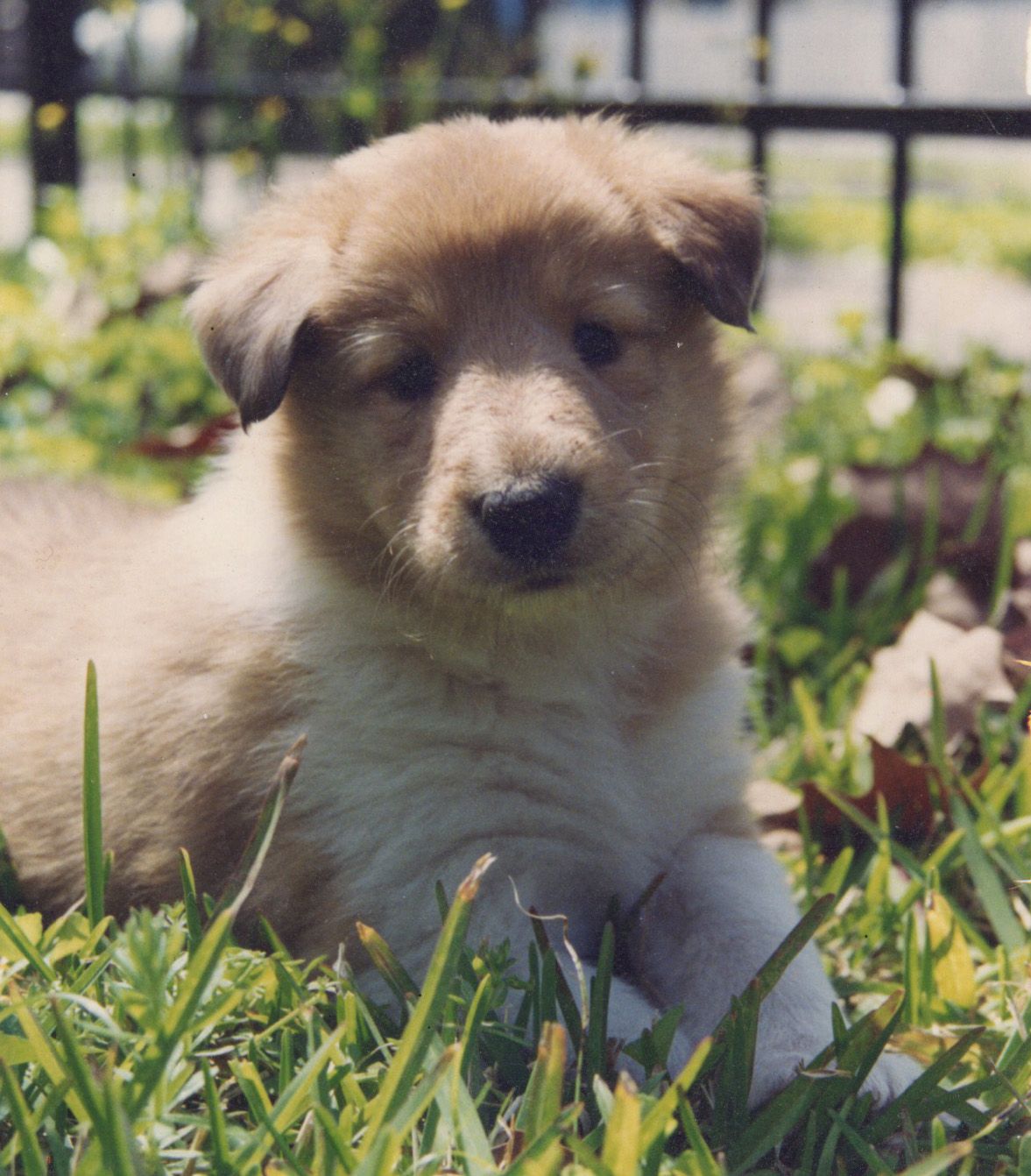
The girlfriend said she’d get the puppy. She tried to sound put out about it, but hey, a cute puppy. I threw the bag in my truck and called the station to tell them I was on my way. They had not confirmed permission with the news director to send me yet, but I told them that they could recall me if it turned out to be a dud. I knew that if there was anything to it, they would be crazed for me to get up there ASAP.
Our satellite truck was still fairly new. It was custom-built for us and had all sorts of bells and whistles. We could send two live feeds simultaneously, there was a switcher for multiple camera setups, an edit system, and an internal phone system that was driven by two cell phone systems, three satellite lines, and even landlines if they were available. There were even two “Trimline” style push button phones mounted on the dash. I wasn’t out of Houston before they started ringing. “Where are you?” “How long you think it will take you?” Yep. Chasing the siren call of spot news.
Before I go any further. Let me explain something about covering news, especially back in those days. By definition, news can be exciting, even a thrill. You get a first-hand view of NEWS. The big fire, political shenanigans, celebrities in fine form (or even better - in the back of a police car.) You see sports megastars suiting up for the championship game or you could find yourself chasing the big storm. On the other hand, you were called to witness horrible tragedies. Tragedies that look different when seen up close, live. If you’ve seen one wreck on a TV screen, you’ve seen a thousand. But when you show up to that scene that is still active, it can be awful to witness. People, sometimes children, in agonizing pain. First responders trying to administer first aid or attempting to keep someone alive. How about a housefire where kids have been killed, and they bring the mother home to tell her? You’ve seen a hundred murder stories on the news. Most news stations will not show any footage that’s too disturbing. But the news crews saw that scene, unfiltered. Do you know how much blood the human body can spill?
TV types are first responders, too, but not in the same way that civil servants are. We’re not the ones putting out the fires, stopping the bleeding, or purposely running toward the gunfire. But it still can be traumatic, and sometimes just as dangerous. You realize that you’re in an absurd profession when you find yourself in the sole vehicle traveling into the path of a hurricane, while the other side of the highway is a river of evacuees driving away from the obvious danger. You know you’re in a bizarre profession when you observe a reporter standing chest deep in flood waters speaking into a microphone, telling a mass audience, “This is what you shouldn’t do. There are sharp objects hidden in the water, snakes and other dangers in these flood waters. So don’t go out into the floods!” Insanity.
How do first responders deal with the constant trauma? Or the nurses and docs in the ER? Or the active military? Or for that matter, the press that covers them? There are a few that just seem built for it. Others probably bury any emotional response, or form unhealthy coping mechanisms in reaction to the things that they see and hear. But most folks develop a gallows sense of humor. That is, they laugh and joke about terrible situations. The “jokes” or references may not make sense to outsiders, or even seem callous and cruel and incredibly insensitive.
It’s the way you’ll hear first responders or field reporters refer to an ambulance as a “meat wagon,” or a coroner’s van as a “body car.” A murder victim might need to be “bagged and tagged.” Someone might ask at a huge apartment fire “does anyone have any marshmallows?”
This is a coping mechanism. To that outsider, probably not funny. Hell, to an insider, often not funny. And some will find it really distasteful. To be clear, there are some situations and scenes where there is simply no possible way to find something silly or crazy to try and keep your mind off of tragedy. The recent Uvalde (and other school) shootings are an example. Children being slaughtered, their parents bearing witness, the incompetent inaction of law enforcement. Those are the days that haunt observers for the rest of their lives.
The phone in the cab was ringing again as I was filling the diesel tanks. I jumped up and grabbed it only to hear the news director ask “How far away are you???” I explained that I was probably a little over halfway there and had stopped to fill-up to make sure I had plenty of fuel for the rest of the trip and a long generator run. His usual ADHD angst was off the charts, “What do you mean? You’ve got to get up there!” I started to realize that this might be a bigger deal than a big house fire or a three-car collision. I topped off the tanks and headed out. The gray clouds wouldn’t break and were bringing more rain and the kind of wet cold air that cuts through you.
All manner of law enforcement was rolling back and forth on the ranch road to Mt. Carmel, the name that the Branch Davidian religious cult called their property. There were only one or two other satellite transmission trucks when I arrived and a couple of Waco and Dallas news vehicles. I had barely gotten into the truck’s workspace when my crew walked in and handed me a video tape cassette. We were great friends, having all worked at the station together for several years. They were based in Austin, and I always made it a point to grab any assignment that was happening in or near the Capitol. Fellow Texas Writer Outlaw James Moore was the reporter and Kirk Swann (who would serve as the best man at my wedding) was his photog. They were not their usual jovial selves and did not greet me with our usual banter. “Make us a dub of this, and feed it out. You’re not going to believe it. Give it right back to me and not anyone else.” I started the generator and cranked everything up.
I loaded the tape into a machine and hit rewind. I threw in another tape to record it to and decided to start the dub even before I got the satellite dish up.
You’ve seen a lot of this footage by now. I sat staring at the little 9-inch color monitor. There they were… dozens of ATF officers charging up to the Branch Davidian compound and were quite literally, ambushed. Remember, this was an era where “mass shootings” were a rarity. This was certainly that, but with the feeling of seeing a war unfold before your eyes. The photographer had been right in the middle of it all. Bullets cut through the thin walls of the main house as agents rushed the building. Several made it to a roof, trying to gain entrance through a second-story window. They retreated back down a ladder, taking multiple hits before they could slide down. Other officers were firing from behind scattered vehicles.
I was sitting at a small work desk, video monitors at my eye level, not believing what I was seeing. I could feel my knees go weak and wobbly even though I was sitting in a chair. I picked up the phone mounted on the equipment rack and called the newsroom. “Send the cavalry,” I said, without a hint of sarcasm. “Send everything. This is history.”
I aimed the satellite dish and found my “bird,” and after making contact with our station’s feed center, I rolled them a copy of the tape as well. I could hear the gasps as people watched the feed come down into the newsroom. In addition to the (quite literally) battle footage, the aftermath was even worse. There had been some form of agreed-upon ceasefire, and the ATF agents were allowed to collect their wounded and dead and leave the field. Several ATF officers could be seen picking up lifeless bodies by arms and legs and carrying them out. The agents grabbed a couple of trucks that had not been shot up and loaded the wounded and dead into and onto these vehicles. Dozens more were forced to hike out. It was a chilling thing to see. The photographer that shot this carnage had been in the thick of it, as seen by the footage. As he continued to roll tape during the retreat, several agents cursed him and demanded he stop. He continued shooting. (He would also later receive thanks from the ATF for helping evacuate the wounded.)
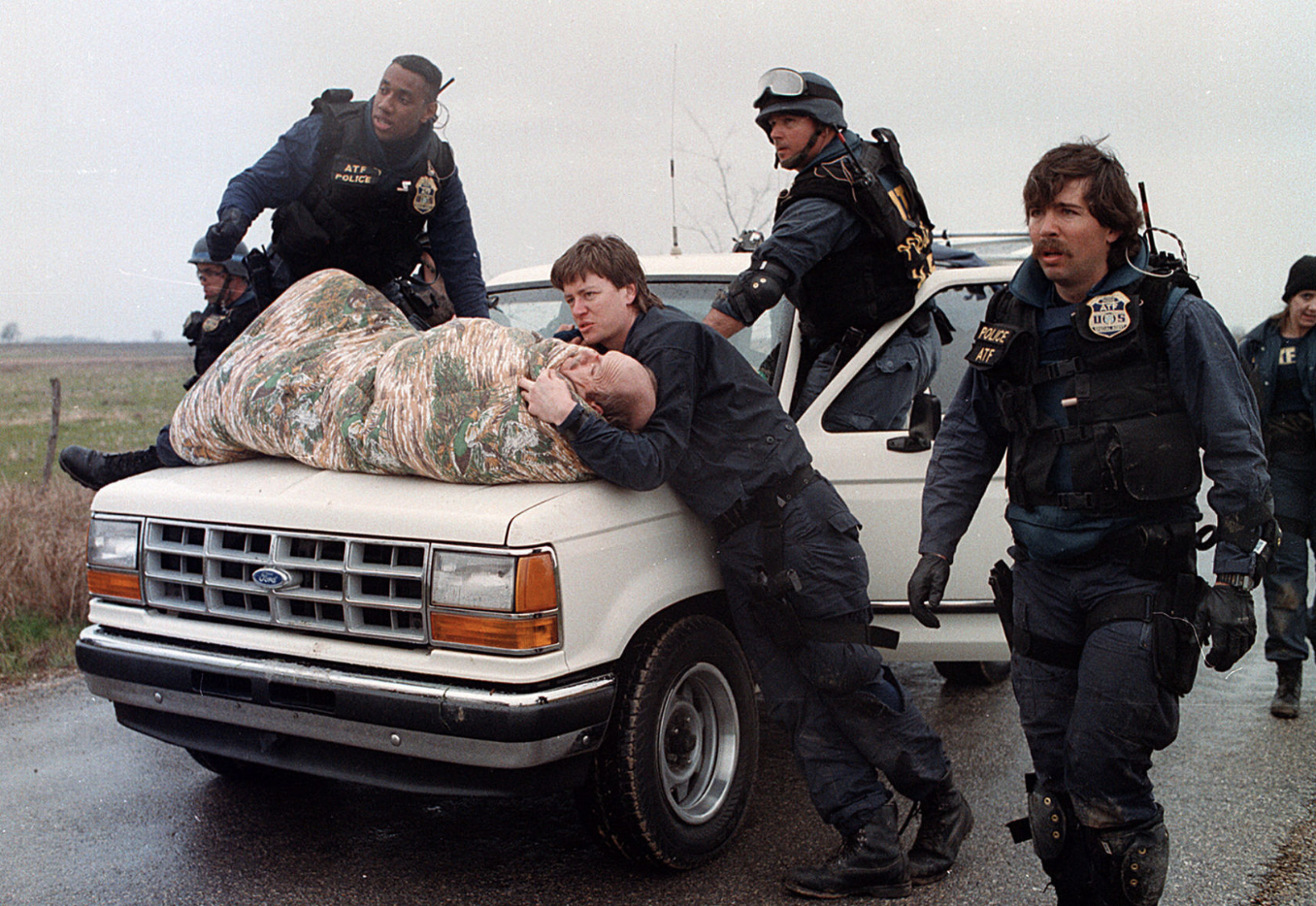
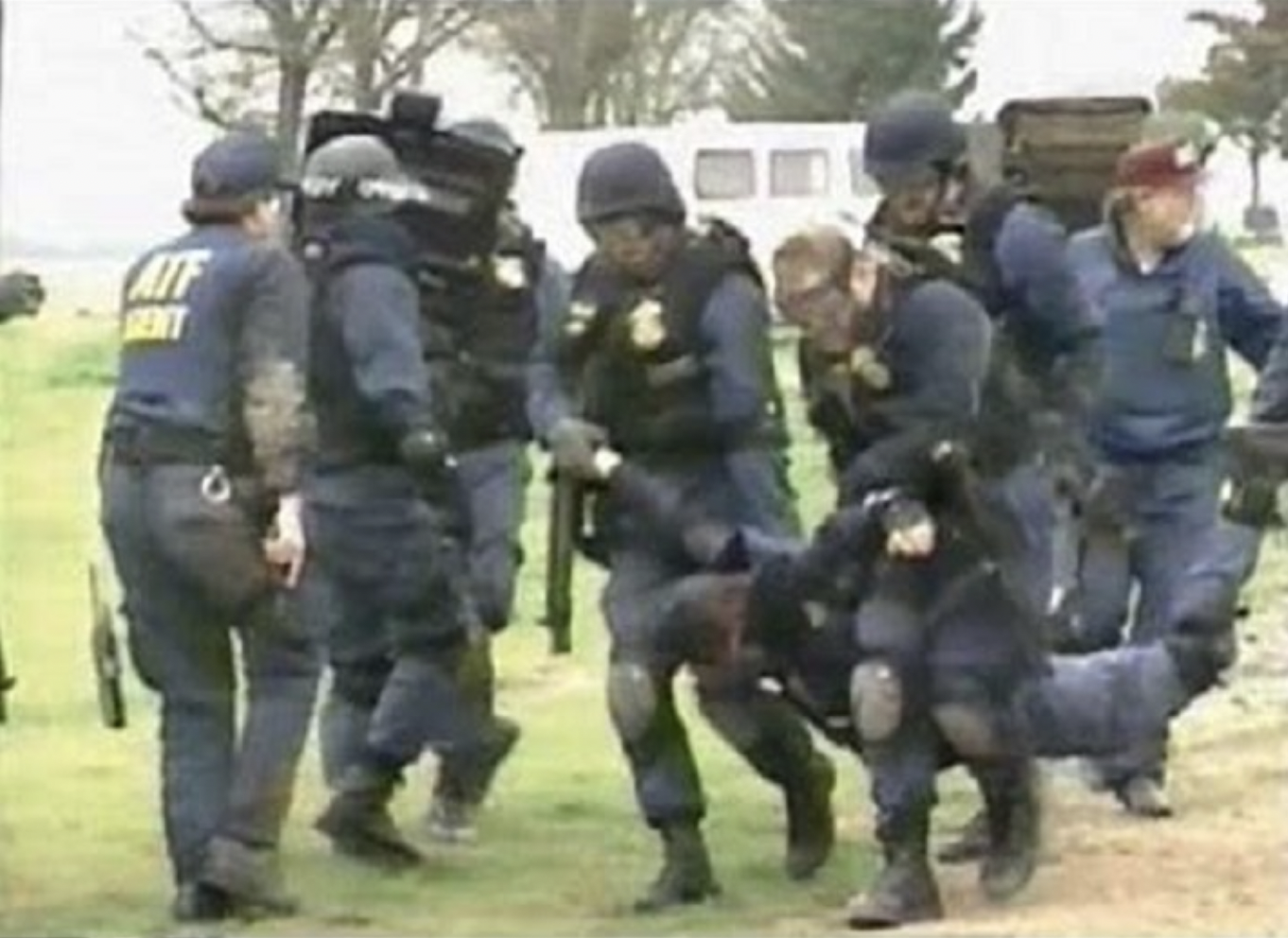
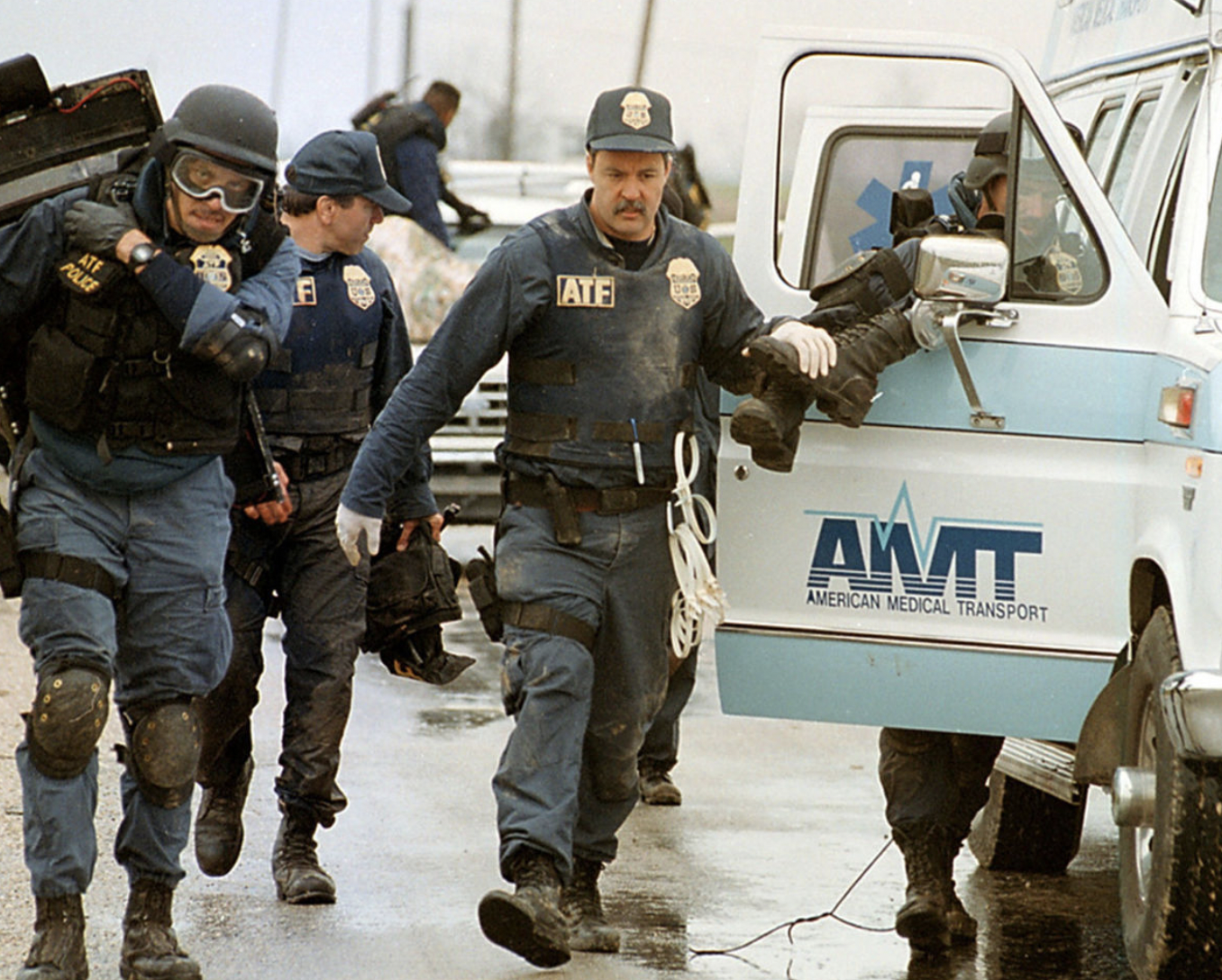
Jim and Kirk were coming in and out of the truck… writing, reviewing footage, making phone calls to the station to deliver story details. Other reporters that were there would stick their heads into the door or pass along some info. At some point a thin, quiet guy came into the truck. He had his camera with him and was even muddier and wetter than we were, and looked pretty pale. He asked if I could make him a dub, too. I looked to Kirk for approval, and he instantly nodded. He left pretty quickly, and Kirk said, “That was the guy that shot this stuff.”
Dan Mulloney worked for KWTX, a Waco TV station. He and another photographer from the station, Jim Peeler, would spend their lives reliving that day. In addition to their own trauma, their presence would be blamed for “tipping off” the Branch Davidians and causing the ambush. The Justice Dept. and other investigations would clear them of wrongdoing, but they both had their careers cut short or limited as no one would consider them for television work. They would both be the subject of lawsuits by Davidian shooting victims. It was later proved that the ATF command staff knew that they had lost the element of surprise through an informant. They gave the “Go” command anyway. (Mulloney drank himself to death, emotionally overwrought. Died alone in a second-floor one-bedroom walkup in Waco. Peeler still works at KWTX and makes less than $25k annually and is almost 70. The courage they showed should have won national awards and got them amazing jobs offers. But the ATF accusations and those of a few print reporters destroyed their careers.)
The local Waco newspaper had been working on a special investigative series on Koresh and the Branch Davidians. The ATF had received reports that the Davidians, noted gun sellers at local gun shows, had modified some AKs into full machine guns. There was also credible information that Koresh was taking multiple wives including underage girls. The ATF wanted The Waco Tribune-Herald to delay publication of their series, "The Sinful Messiah,” but after weeks of delays, they went to press with it on February 27. It was only then that the paper and TV photographers were tipped that a raid was imminent. Though denied later, that tip came from someone in the Sheriff’s office. The tip was confirmed by Mulloney’s girlfriend who worked at a local ambulance company that had been engaged to stand by on the morning of the raid.
Agents had been seen outfitting for the raid the night before. On Sunday morning, the area was thick with ATF, FBI, state troopers, sheriff cars, and ambulances. The majority of agents that suited up in battle gear for the raid were loaded into two large cattle trailers that were to be driven into the compound. A Trojan Horse trailer, if you will. These had been observed, as well. Helicopters were in the area. To pretend that this would be a surprise was a fantasy.
Who fired the first shot? The search warrant that the ATF carried to search the compound was never served, the gunfire started almost immediately. Each side later blamed the other. Most evidence points to the government, even if it was a shot fired accidentally. It was instantly a war zone. Three National Guard Black Hawk helicopters flew in as some sort of diversion and were to be observation platforms. Scared that the choppers were shooting at them, the Davidians shot at and hit the choppers, though no one was injured. The aircraft set down quickly nearby to avoid further damage and risk. Somehow, this was misconstrued/exaggerated as the crash of an aircraft/airplane. Which explained the first “breaking news” stories on cable news.
The gunfire would last for two solid hours before a ceasefire could be negotiated. Five Branch Davidians were dead. (Another would be killed by a sniper later in the day when he allegedly fired a pistol at the ATF.) Eleven, including Koresh, were wounded. The ATF lost four agents and sixteen were wounded.
The first afternoon and evening after the siege was hectic. Traffic was pretty thick with all manner of emergency responders, government cars, (the FBI would almost immediately assume command of the operation,) and state and local law enforcement. For us, there were stories and interviews to feed and live reports to get on the air. It wasn’t long before law enforcement wanted us to move away from the turnoff to the compound. So, we packed up and moved a half mile or so up the road. Other crews began to arrive. Our TV station alone was loosely partnered with other CBS affiliates, our ownership group (which controlled several TV stations and would want us to share resources with them,) and even CNN.
We had too much to do to head into town that first night, but calls were made and we found that hotels were being booked up pretty quickly. In addition to the media (domestic and foreign,) the FBI, state troopers, the ATF, and neighboring sheriff’s officers were all checking into area hotels. For the first couple of nights, we would take turns trying to catch an hour or two of sleep in the cab or in the photographer’s trucks. (Worth noting, in Jim Moore’s piece “What Really Happened at Waco,” another tipoff was that the ATF had taken over the Hilton on the Brazos River downtown two nights before the raid. They literally kicked out a building full of travel writers, who were in town for a Waco tour, and sent them down the road to motels in Hillsborough.)
By morning light, we had already done several live shots for the local and national morning shows. A steady stream of news vehicles and satellite trucks was parking on the side of the road. Reporters and crews were desperate to have a copy of the original siege tape to edit their own stories. People were seeking out witnesses, survivors, or commanders authorized to speak to the press. The frenzy had begun.
During the “standoff” period, most official news of what was happening inside the compound was strictly controlled and delivered by the FBI. A press room of sorts was established closer to town. Most of the information that they released was not detailed, and of course, delivered to demonize Koresh and his cult of followers and deflect blame for the government’s botched raid. The first week of press conferences was antagonistic as dozens of reporters needled the FBI spokesperson for reasons why the raid had been such a spectacular failure. In a word, things were tense.
Reporters went in search of local townspeople who knew the Davidians, local reporters that had worked on the big newspaper expose, the photographers that had been in the middle of the gunfight, lawyers and experts knowledgeable on what laws were being broken, and any kind of insight that anyone in the area could give.
We could still see the compound, at least for a day or two. As soon as they had some armored vehicles, the FBI was pretty ruthless in clearing away the shot-up cars on the property, taking extra care to smash David Koresh’s personal vehicle. They set up lights to illuminate the area and shine harshly into the compound at night. The Davidians would hang sheets with messages painted on them outside their windows. For a few days, reporters would actually call in to Koresh for interviews. This worked until the FBI cut that cable and wired themselves a direct and exclusive phone to the compound.
As we searched and ultimately found a handful of hotel rooms, another problem became immediately obvious. We were out on a country road, a good 10 miles from the outskirts of Waco. For a day or two, men could get away with relieving themselves on the far side of a truck or behind a small clump of brush… but we were without any real amenities. Women reporters and crew members were at a real disadvantage, and as the press pack grew, it became risky to try and “find a tree” for purposes of bodily necessities. This also meant that food and fuel were twenty minutes away. The crews were running nearly 24 hours a day – no one wanted to miss how the story might shift. Everyone wanted to monitor what the feds were up to in the middle of the night, or if the Davidians might try something crazy. We would take turns running into town, fetching meals, taking bathroom breaks, refilling the ice chest, making fuel run.
We got pushed again further up the road… ‘for our safety.' In reality, the FBI was getting tired of their tactics being observed by the press corp. After a few days, troopers established a roadblock a mile or so away from the compound. We were forced to set up behind that line. (The public was restricted even further out.) By this time, RVs were being rented as were box trucks. The large yellow Ryder trucks provided shade and a workspace that kept some crews out of the weather. Ironically, it was a similar yellow Ryder Truck that Timothy McVeigh would use to deliver his massive bomb in Oklahoma City.
Our group rented a small corner of a farmer’s field and set the satellite truck there. We would add a rented RV, some tarps, and a picnic table or two to form our own compound.
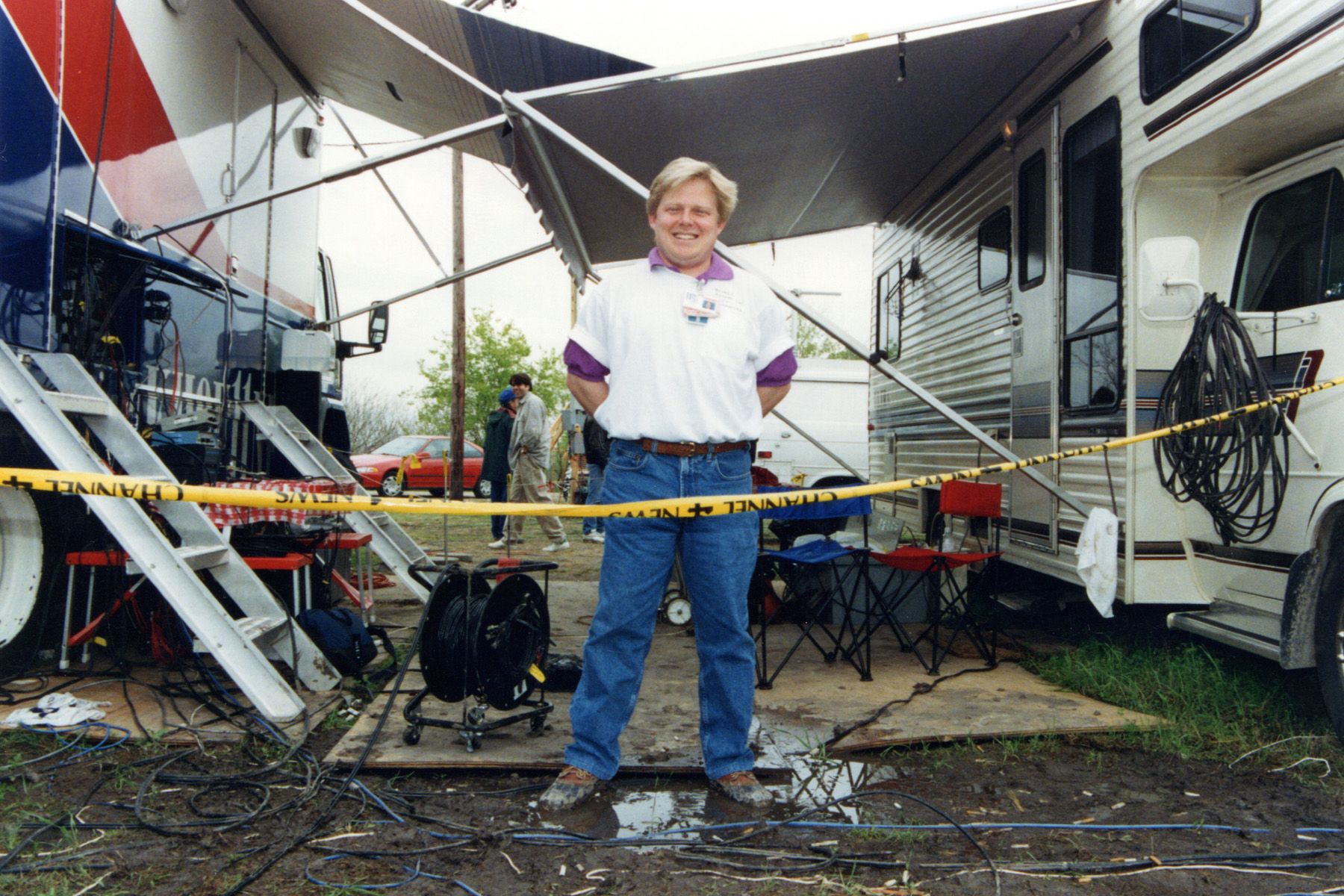
The days began to tick by. The circus grew and grew. More trucks, more rent cars, more satellite dishes, more cameras and reporters. It was not unusual for a foreign press crew to knock on our door to ask to feed a story back to Japan, or France, or Britain.
These were the days of massive local press responses, so we met crews from all over the state and nation. Cable TV was just starting to eat into local station profits and the internet was still a novelty on the distant horizon. TV stations continued spending like there weren’t 30 twenty-four hour cable news channels around the corner. The local news “brand” depended on saturation coverage and “being there” for breaking news or traveling sports teams. In this era, local news outlets would send their own reporters to cover political conventions, celebrity trials across the country, and any out-of-town game from a local sports team.
Other members of our engineering group (as well as photographers and reporters) in Houston wanted a turn at the biggest story of the year, and possibly the decade. They also wanted a turn at some solid overtime pay. I certainly needed some clean clothes and a break to check on the house, the girlfriend, and Sissy, that collie puppy. It was decided that there would be rotations of personnel that wanted to go. The station was shuttling crews via the station’s helicopter. This was handy since my ride was the satellite truck, and it needed to stay in Waco.
My house was as unkempt as I left it, the girlfriend missed me, and Sissy had already gnawed a couple table legs into pulp with her puppy teeth. When I got back into town, it was interesting to see how much of our newscast was devoted to the big story, and how it was being covered by other stations and cable outlets. It was also interesting to hear the reactions to what was happening, both inside the newsroom and out in public. And best of all? I got my first paycheck that reflected some of my time and overtime out in the field.
As exhausted as I had been, I caught up on my sleep pretty quickly. I was surprised at how bored I got, and how anxious I became when I watched the news feeds come in before the newscasts. Like Capt. Willard in “Apocalypse Now”…
”When I was here, I wanted to be there; when I was there, all I could think of was getting back into the jungle. I'm here a week now... waiting for a mission... getting softer.”
… “Everyone gets everything he wants. I wanted a mission, and for my sins they gave me one.”
A few days later, I packed my truck with all manner of camping gear, more appropriate clothing, and music CDs, (the satellite truck designer, in a nod to the crew members that would operate it, incorporated a nice little sound system inside the truck.) I took some outdoor cooking gear like Dutch ovens and charcoal along with lawn chairs and portable tables. When I showed up on the station’s helipad, the pilot shook his head and informed me that he felt like he was taking his daughters off to summer camp. We also took more electronics, cases of blank video tape, office supplies, and cabling. Indeed, the A-Star helicopter more resembled an overloaded station wagon with a rotor blade on top. Somehow, we managed to lift off of the roof.
In the few days that I had been gone, the road to Mt. Carmel had gone from “circus” to full-blown “Fellini.” It was packed with vehicles for what seemed like miles. More semi-permanent encampments had sprouted up. The news agencies had banded together and elected a mayor. This was more than a silly gesture. The “mayor” helped schedule fuel deliveries for the many diesel generators. He kept a tab on people sharing the expense of multiple Port-O-Potties (and their maintenance.) He became the point person when law enforcement needed to change the rules of the road.
Broadcast equipment vendors and technicians started to show up. Several engineers had banded together and built a camera tower and were able to use some super long telephoto lenses to observe the compound. Another group set up an infrared camera lens to watch the property at night. Mostly, we used it to watch grainy black and white night video of small packs of coyotes wandering around the compound.
Things settled into a routine. It was a standoff with no resolution in sight. Almost as soon as the FBI had established a communications post with their hostage negotiators, Koresh had been convinced to let some of the children go. Dozens of photographers lined the road to get a 5-second shot of a couple of vans drive by with 19 Branch Davidian children being taken off to Children’s Protective Services. Koresh would later also send several adults out of the house. Early on, the FBI Hostage Negotiating Team thought that they could wrap everything up fairly quickly after Koresh asked to broadcast a message on the radio… in return he promised to surrender along with the rest of the Davidians.
The FBI granted the request. Koresh made his radio broadcast and then delayed any type of surrender, informing the negotiators that God told him not to give up. The FBI tactical Hostage Rescue Team would ramp up their provocations to force a surrender. This entailed playing loud music and piercing sound effects throughout the night. This “psych ops” effort was to weaken the Davidians through sleep deprivation. It didn’t take a Ph.D. in actual psychology to realize that this didn’t weaken them, but only angered them and strengthened their resolve to resist the government’s effort to find a peaceful resolution.
Recordings would later reveal that Koresh would drone on for hours with the negotiators about his prophecies. Internally, it was referred to as “Bible babble.” He insisted that he was writing prophetic revelations. He also began to speak of himself as the Second Coming who was talking directly to and taking direction from God.
Days turned into weeks. A resolution was always just around the corner. Koresh would promise to write his final prophecy so the Davidians could walk out. Or the Rescue Team would talk of a raid to arrest them all. It was apparent to all, by the way, that the negotiators looking for a peaceful end to the impasse were butting heads with the militant Hostage Rescue Team. The "HRT" was loaded for bear and wanted to play army, maybe exact some revenge. More military gear trickled in. Armored vehicles crawled around and Huey helicopters buzzed overhead. It was as if none of them had enough self-awareness to recognize that charging in with guns blazing had been exactly their first mistake. The fever was high to make it their last mistake, too.
Reporters kept questioning why there had been a need for the original siege. Townspeople had come forth to reveal that Koresh kept a fairly regular routine. He made trips into town for groceries and supplies. He was known to take fairly frequent runs along the country roads. (He ran on the Baylor track every Tuesday and Thursday to flirt with co-eds) The local sheriff (who had a fairly civil relationship with the Davidians) had even asked the ATF why didn’t they “just go down and talk to him?”
The road to Mt. Carmel was getting weirder by the day. One of the other Houston affiliates had put up an Astroturf lawn, complete with a small picket fence and lawn ornaments. Our own muddy compound was at least as comfortable as a retiree’s RV park. A sense of boredom and monotony had set in, broken periodically by an alert that SOMETHING WAS ABOUT TO HAPPEN! But on most days, reporters had to scramble to find something substantive to talk about. There was a need to check the daily press releases and press conferences. At the same time, reporters were desperately hustling to find a new angle - an ex-Davidian, a grieving family member. They also had to cover their asses so as not to miss any action on the road to the compound. On any given day you would find reporters reporting on… other reporters. The situation had devolved into stories on "a day in the life along press row.” “How does the press pack do it, all the way out here in the middle of nowhere?” “Hey, look, wacky lawn ornaments decorate Channel X’s satellite truck!”
Weeks after it was over, I was visiting my grandparents and mom in South Texas. They all lived together in the same smart, clear-headed household, though my grandad had lost his eyesight to glaucoma a year or so earlier. When he wasn’t listening to ‘books on tape,” my grandad could be found in his easy chair with CNN on in the background. My mom told me that one day she and my grandmother came in to hear my grandad tell them that I had been on TV. They certainly knew that I had been in and out of Waco for this big story. But they thought he was being silly, he was blind! How could he have seen me on TV! But as cable news does, stories repeated during the day, and just an hour or so later, a soft feature story on “life around the Davidian Compound” came on. A reporter was walking through the various work sites and weaving in and out of satellite trucks when he caught me making the crew lunch in those Dutch ovens over a charcoal fire. I made some snarky, offhand remark to him and his photographer, had a laugh and carried on. My blind grandad had been right. I had been on TV.
News organizations desperately wanted an old-fashioned scoop. They wanted to grab a lead that no one else had. But yes, like many news “gang bangs,” there was a certain disconnect. (“Gang bang” is newsroom slang for a breaking news scene where multiple news agencies are all there at once. Tasteless reference, yes. I warned you.) The disconnect, as usual, was that the majority of the reports were a perfunctory recitation of the widely disseminated (and often questionable) “facts” by the government. No one was on the “inside.” Everyone cared and everyone was trying their best to deliver an honest news report, but we were almost two miles from the news. We were staff schlubs, making great overtime pay, trying to deliver a good story… and maybe keep our sanity around what was a bizarre situation.
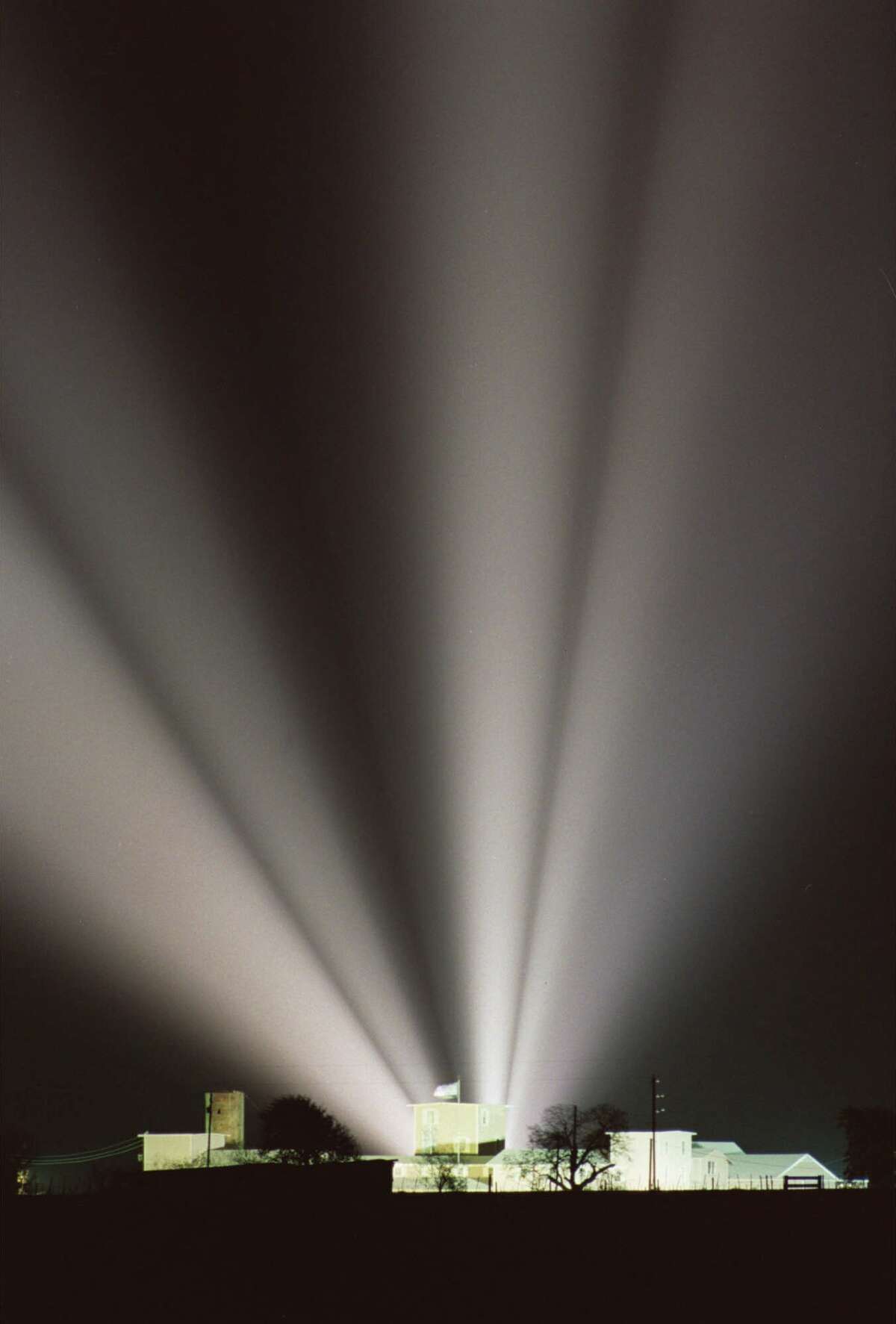
On one of my last trips home, I kissed my girl, petted that wildly growing puppy, and got to sleep in my quiet comfortable bed, away from spotlights cutting through the cold night sky and heavy metal music/Halloween screams blaring away. I also had time to confirm some airline tickets I had for Vegas in a couple weeks, around April 18. A buddy of mine at the TV station and I had discussed going “freelance” - working independently for the various networks on stories like Waco. The network news operations were cutting back on staff positions and were relying more heavily on independent crews that they could hire as they needed. Houston and Texas were always hot news markets (for obvious reasons.) We were going to travel to Las Vegas to attend “NAB.” The National Association of Broadcasters held a massive trade show that showcased broadcast camera gear and other equipment that we would need if we were going to be a freelance video crew. And after this overtime pay bonanza at Waco, we would have some the extra money we needed to finance some of that gear to give us a head start on our new career path.
I had no time to sign on for another shift at the compound. By now, things were so routine that there were hours of boredom. There was maintenance to do, muddy cables that were drying out and needing cleaning, and always some small bit of new information that could be reported on. But the managers back home had been adding things up, and even in the era of flush profits from local news, the bean counters in accounting were sounding alarms. We were cutting back to maybe two full-time crews assigned to the story, and they had to cover everything and appear on the earliest of early morning programs all the way to the ten o’clock news. The initial sensationalism had worn off, and many of the foreign journalists and small market stations had gone home. Still, tick-tock went the overtime clock.
We all knew about the loss of life and the risk of even more lives being lost as the militant “rescue team” stomped around the compound, smashing more of the Davidians’ vehicles, even rolling their tanks over one of the follower’s fresh graves. The FBI (and independent observers) had identified the Davidians as a doomsday, “Apocalyptic” cult, one that had an intense focus on the End Times. There was some fear that this could all end in a kind of Jim Jones type scenario – a group suicide of some kind. Koresh kept focusing on his need to complete his prophetic writings that he had dubbed “The Seven Seals.” He ignored deadlines that he agreed on with the FBI. The militant Hostage Rescue Team was adamant that more underage girls were being abused. Food and water were in short supply. They were advocating for a tactical raid or “rescue.”
The press corps was fully aware of the reports of his abusive, controlling, (and many thought,) evil behavior. (CPS investigated the compound twice and found zero evidence of child abuse. There were only adults admitting that wives were having sex with Koresh. However, the later investigations would prove the rumors to be true.) They had also of course, seen and broadcast the tapes of the ATF’s incompetent and unnecessarily lethal response at the initial siege. And while some reporters believed that their solid reporting might lead to a greater awareness of this historic moment, almost all were fairly certain that there was nothing that they could do to change the outcome, whatever that might be. Good journalists strive to report what they’ve observed in a (pardon the overused, often untrue expression) “fair and objective manner.” It’s not their job to put the fire out once it starts. But it can be painful to feel the heat build as you sound the warning.
But that was all nearly two miles down the road. There were lawyers and even a few Davidian relatives frequently coming through the checkpoint to try and speak with Koresh and his followers. A few of the motivated reporters were able to get statements from them. But mostly it had become routine… press conferences… file footage… live shots…
After a quick trip home and a couple of days to regroup, do laundry and re-pack, (girlfriend good, Sissy chewing more furniture, house holding up…) my buddy and I were off to Las Vegas. I was excited to forget Waco and go on a grand shopping spree in prep for a big career change. I’m not a gambler or a big fan of Vegas, but the prospect of networking with some of the same freelance pros that had been on the roadside in Waco was something to look forward to.
The show was a sensory overload with the biggest names in broadcast gear having a presence there, along with hundreds of small vendors specializing in everything from cameras and microphones to custom-made cables and wires. Sony alone had exhibit space about the size of a city block. There was research, shopping, and maybe a little gambling and drinking - just to take in the full Vegas experience. On day two, we did not put in for an early wake-up call. But midmorning, my pager started going off. It was my girlfriend’s phone number with a “911” attached to the end of it. I grabbed the phone and called her. All she could say was “are you watching?” I didn’t understand. “The TV, turn on the TV! The compound is on fire!”
We flipped on the hotel room TV to cable news, and there was a shot of the Mt. Carmel prairie, with smoke billowing in the distance. Well, it looked like the same tower camera angle we had seen for weeks, but they were evidently pointed in the wrong direction, there was no compound. “No, THAT’S IT! It’s gone, the fire has burned the whole thing up!” It took us a couple of minutes to even process what we were seeing.
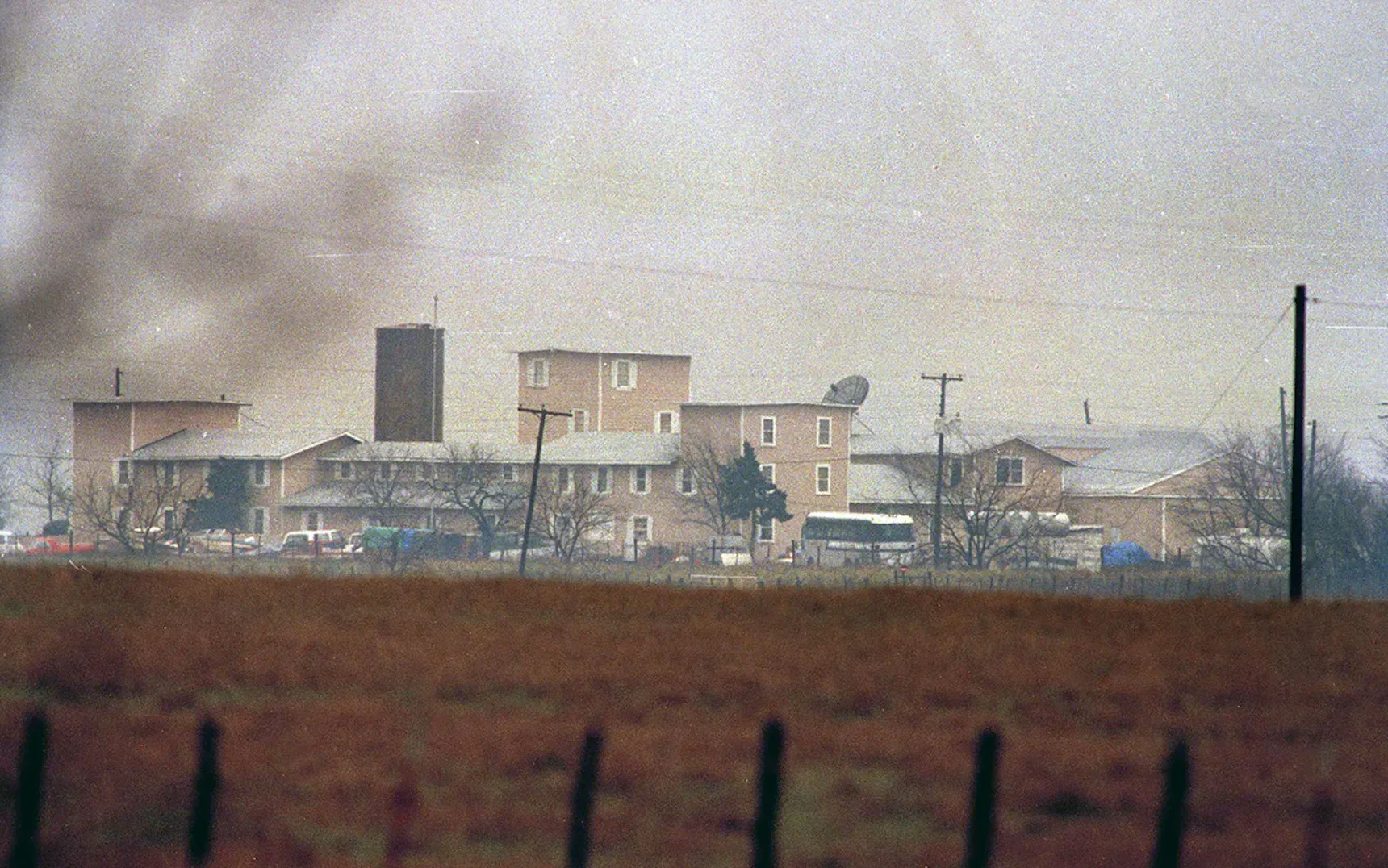
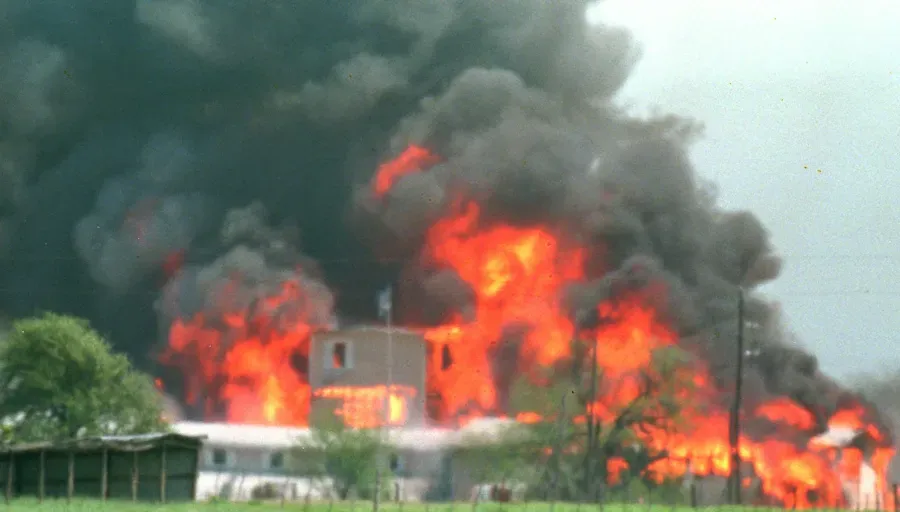
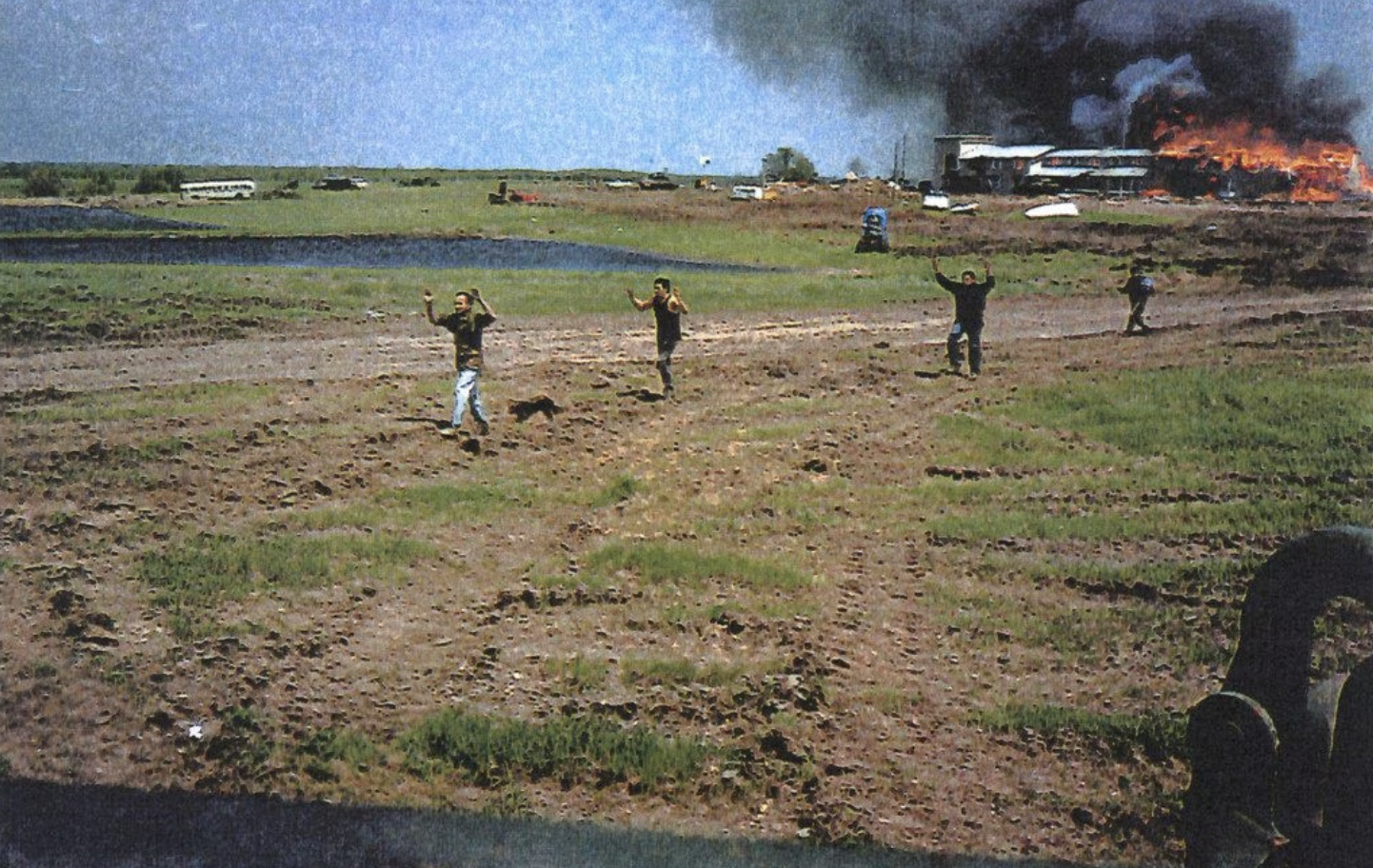
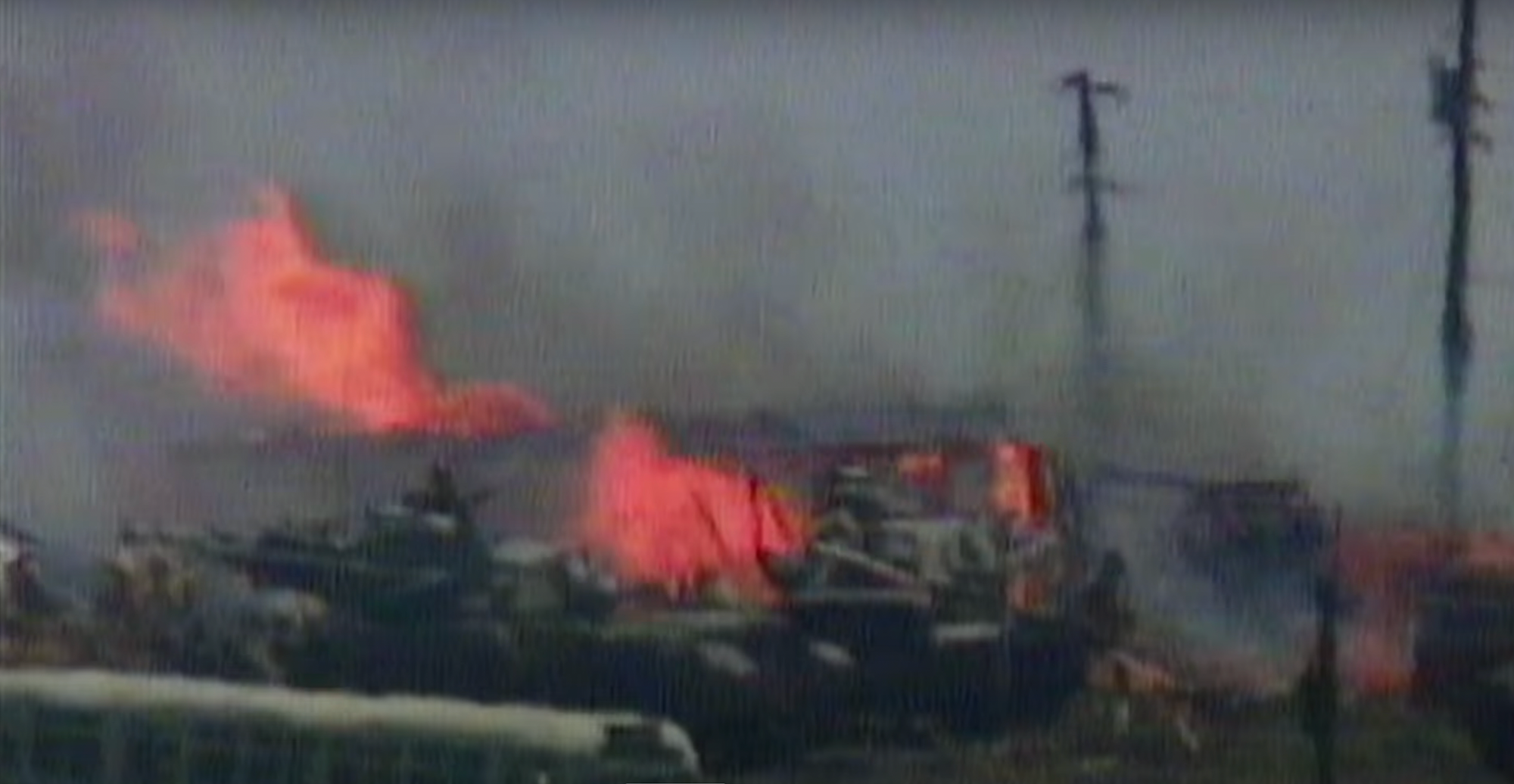
You know the story. The FBI Hostage “Rescue” Team had decided to make an assault with their armored vehicles and pump tear gas into the building via long snorkel-type tubes punched into the walls of the compound. They were also crashing into the walls of the place, tearing huge gashes where Davidians could come through to surrender… well, that was the plan. Somehow, a fire or fires started during this operation, and the place was totally engulfed in a matter of minutes. A few came out, but 76 people, including Koresh perished in the flames. It was true, then. They were an apocalyptic, suicidal cult.
Surprise.
Our pagers beeped a few more times – it was the newsroom. They wanted to send us to Waco… having forgotten that we were a couple of states away on vacation time. Instead, we took a shuttle back to the convention center to continue our own mission. The massive space was eerily quiet. In any broadcast gear show, you have thousands of state-of-the-art video monitors… from tiny, portable monitors all the way up to gigantic projectors. There are usually multiple screens in every booth. And on every monitor in every space that day was the live feed coming from Mt. Carmel near Waco, TX. Attendees remained hushed all day as they stared in disbelief at the screens.
Koresh died of course, but sadly and somewhat ironically, his twisted legacy lives on. From the Oklahoma City bombers to the current anti-government militia groups, he remains their martyr.
After I returned to Houston, I was sent one last time to Mt. Carmel. The roadblocks were gone, as were most of the satellite trucks. The mayor of our little press village had long since abdicated, and along the shoulder were just a few remaining crews. The manic “breaking news” energy was long gone. The compound itself was sealed off, investigations would go on for months.
No one in the ATF or FBI would so much as get fired for their indefensible operation and ultimate failures that lead to the deaths of 86 people, including women, children and 4 ATF agents. The reporters that were there on the initial raid have suffered from guilt, blame, and lawsuits for their legitimate pursuit of the story. Koresh died of course, but sadly and somewhat ironically, his twisted legacy lives on. From the Oklahoma City bombers to the current anti-government militia groups, he remains their martyr.
We reeled in what seemed like miles of cable and disassembled all kinds of technology that had been exciting to use a few weeks ago. We turned in the RV, folded the tarps and stowed the sat dish. The wind blew through the greening prairie grass, unobstructed by the once iconic building. Piles of litter tumbled into the fence line. The parade had left town, all the clowns and highwire acts were on the move, ready for the next dog and pony show. There was always another one, and it seems you and I are helpless to stop them.
The salty breeze in the British Virgin Islands popped open the spinnaker, and we set a course for Cane Garden Bay out of Road Town, Tortola. Kirk was our captain. He and I had each brought our girlfriends with us. Sissy (the collie) stayed at home. It was a weeklong trip of blue skies and fair winds and a couple of couples grinning ear to ear.
Every rum punch toast was made to David Koresh. Each toast was accompanied by an unselfconscious chuckle. The overtime pay put us on a bareboat sailing adventure that we still talk about. One night I conspired with another boatmate to hide something in a big tire swing on the beach. A short time later, as we walked by, I told my girlfriend to look inside the tire swing. She opened up an engagement ring, and accepted my proposal. We still hold up that ring sometimes and giggle when we thank Koresh for buying her ring.
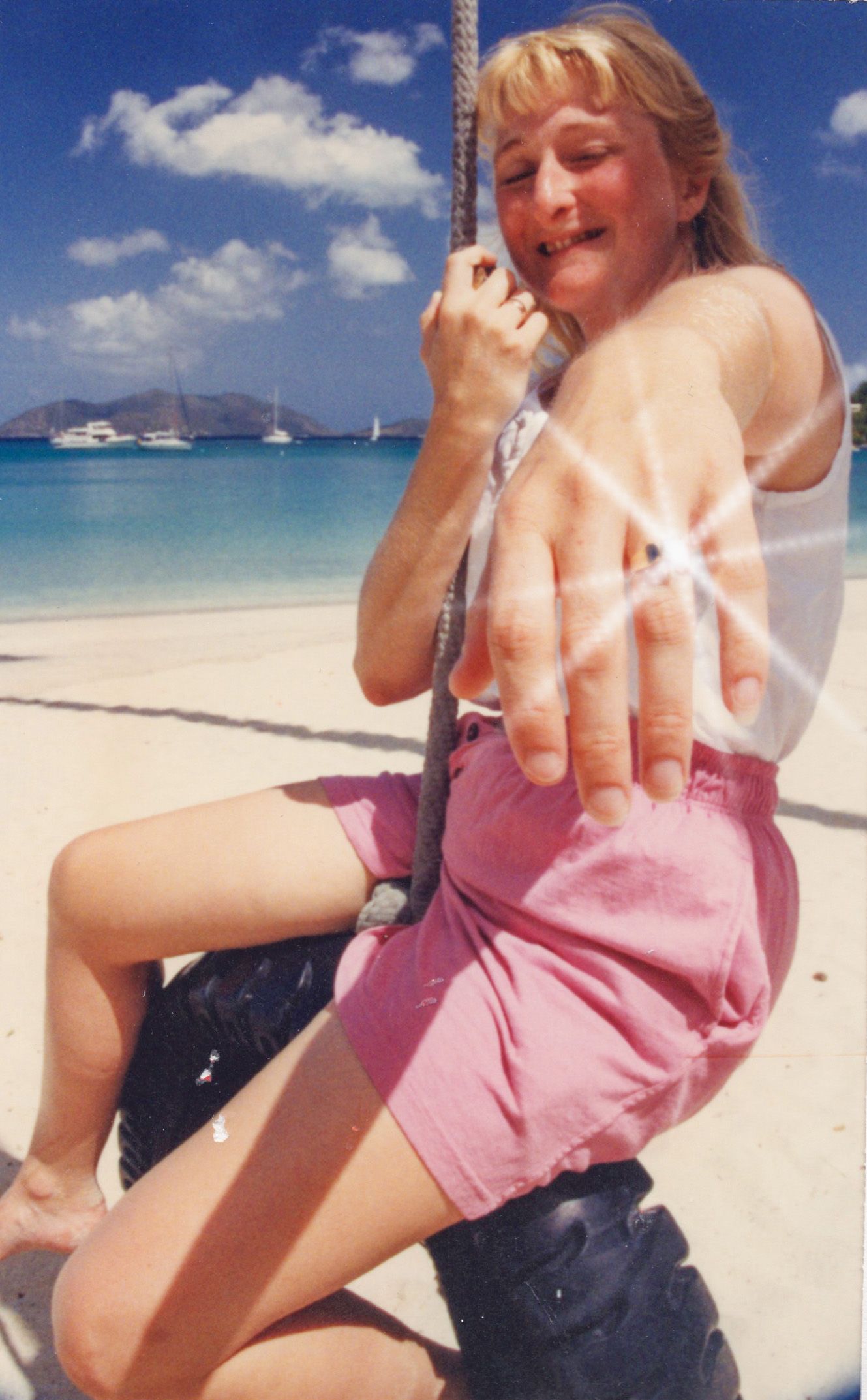
We’re still married. With three grown boys, and four grandchildren. Sissy the collie passed a long time ago, but there’s an old photo of her that we take out a few times a year and remember those days.
It's twisted It’s complicated. Oh, and there’s nothing at all funny about the Branch Davidian standoff, the “Sinful Messiah” and an incompetent, gun-happy government.
I know.
Author’s note: There is plenty more detailed information on the raid, the standoff, and the final inferno that killed most of the remaining Davidians. Every year there are reflections produced in TV and print. The Justice Dept’s report that was released after exhaustive investigations was surprisingly close to what many of us observed and reported. (There were several details not covered.) Some good documentaries have been produced over the years, and it seems new evidence presents itself all the time. Witnesses, Brand Davidians, and law enforcement personnel decide to give their version after years of silence. Movies and TV series have been written and filmed. Some were interesting, very few were complete.
If you seek out information, you could always start with my fellow Outlaw Jim Moore’s recent report right here in our newsletter. (He was there longer than I was.) You can read the full report produced by the Justice Dept. There are dozens of articles in Texas Monthly. The Koresh/Davidian book list could fill a small-town library, three new ones are coming out this year. Frontline (on PBS) has produced several good documentaries. There are Netflix and other streaming movies.
Whatever you do, stay away from the crap. There are countless conspiracy theory sites that will take you down a thousand flat-earther/Q-Anon rabbit holes. There has always been a strain of government distrust and resentment. In post-Vietnam/post-Watergate America, that strain grew to infect our nation’s culture and political landscape. The Waco siege not only took this distrust into a hatred for some, but it exploded into an anti-government movement that found its cornerstone in Waco.
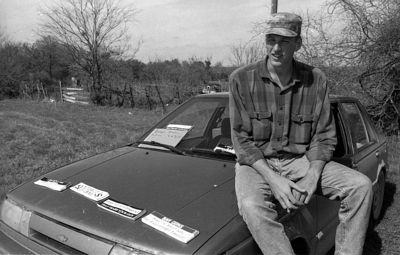
It’s important not to forget that even in the middle of the standoff, protestors were gathered at the roadblocks and along the shoulders of the roads leading to the compound. There is a photograph of Timothy McVeigh handing out anti-government flyers. McVeigh would bomb the Alfred P. Murrah Federal Building in Oklahoma City, two years later on April 19, 1995, killing 168 and injuring nearly 700 more. He would cite the Waco siege as his motivation (along with the Ruby Ridge incident.) Another observer was a young and trim Alex Jones who would begin a public access cable show in Austin, channeling his anger over the Davidian attack. This would grow into the InfoWars network where he has continued to peddle conspiracy theories (and testosterone supplements) to an angry and gullible crowd. Former President Trump kicked off his 2024 campaign in Waco on March 25th of this year, the 30th anniversary of the siege. The choice of place and time was lost on no one, though he denied it was anything but a random choice. He framed his candidacy in apocalyptic terms worthy of the ground near where David Koresh once preached. "... 2024 is the final battle, it’s going to be the big one." He not only promised to save the crowd, but that he would exact vengeance for them. "I am your warrior, I am your justice. For those who have been wronged and betrayed … I am your retribution.".